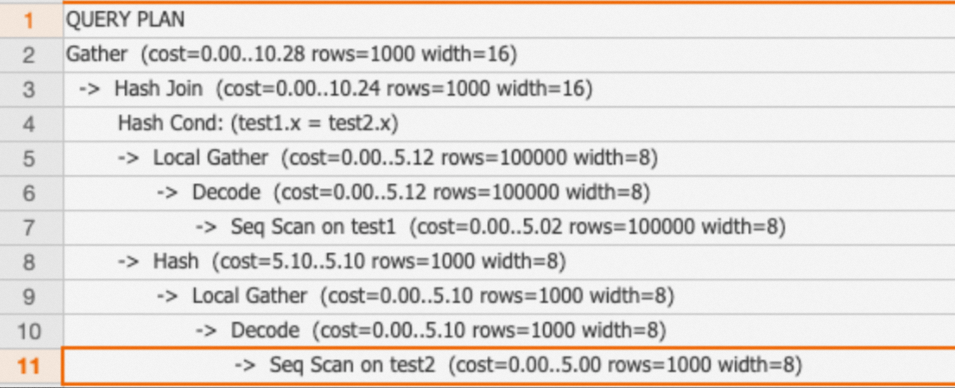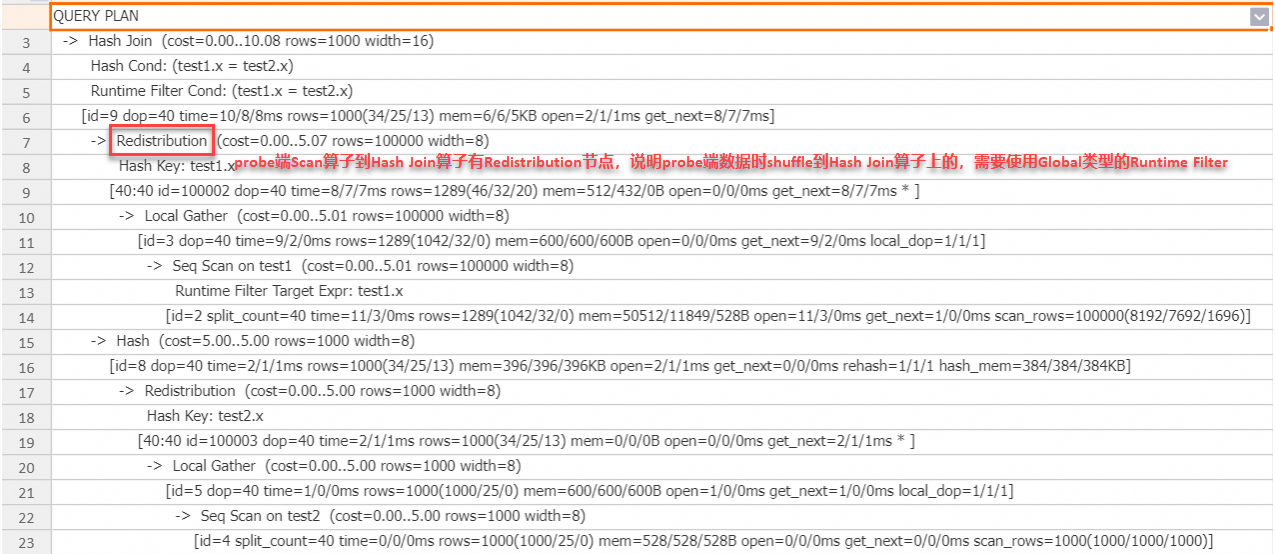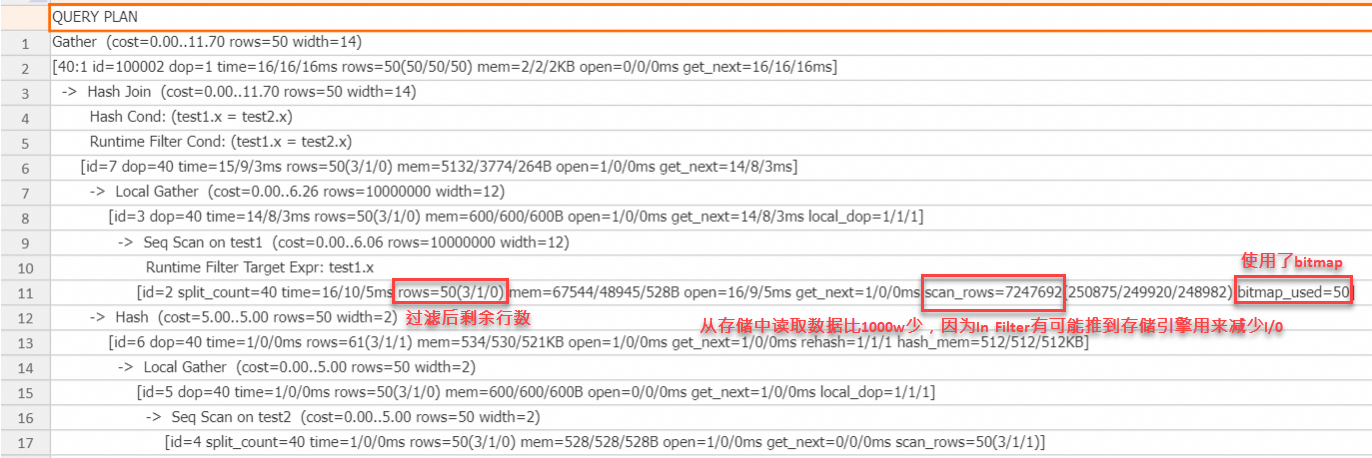Hologres從V2.0版本開始支援Runtime Filter,在多表Join情境下自動最佳化Join過程的過濾行為,提升Join的查詢效能。本文為您介紹在Hologres中Runtime Filter的使用。
背景資訊
應用情境
Hologres從V2.0版本開始支援Runtime Filter,通常應用在多表(兩表及以上)Join的Hash Join情境,尤其是大表Join小表的情境中,無需手動設定,最佳化器和執行引擎會在查詢時自動最佳化Join過程的過濾行為,從而降低I/O開銷,以提升Join的查詢效能。
原理介紹
在瞭解Runtime Filter原理之前,需先瞭解Join過程。兩個表Join的SQL樣本如下:
select * from test1 join test2 on test1.x = test2.x;其對應的執行計畫如下。

如上執行計畫,兩個表Join時,會通過test2表構建Hash表,然後匹配test1表的資料,最後返回結果。在這個過程中,Join時會涉及到兩個名詞:
build端:兩表(或者子查詢)做Hash Join時,其中一張表(子查詢)的資料會構建成Hash表,這一部分稱為build端,對應計劃裡的Hash節點。
probe端:Hash Join的另一邊,主要是讀取資料然後和build端的Hash表進行匹配,這一部分稱為probe端。
通常來說,在執行計畫正確的情況下,小表是build端,大表是probe端。
Runtime Filter的原理就是在HashJoin過程中,利用build端的資料分布,產生一個輕量的過濾器(filter),發送給probe端,對probe端的資料進行裁剪,從而減少probe端真正參與Hash Join以及網路傳輸的資料量,以此來提升Hash Join效能。
因此Runtime Filter更適用於大小表Join,且表資料量相差較大的情境,效能將會比普通Join有更多的提升。
使用限制和觸發條件
使用限制
僅Hologres V2.0及以上版本支援Runtime Filter。
僅支援Join條件中只有一個欄位,如果有多個欄位將不會觸發Runtime Filter。從Hologres V2.1版本開始,Runtime Filter支援多個欄位Join,如果多個Join欄位滿足觸發條件,也會觸發Runtime Filter。
觸發條件
Hologres本身支援高效能的Join,因此Runtime Filter會根據查詢條件在底層自動觸發,但是需要SQL滿足下述所有條件才能觸發:
probe端的資料量在100000行及以上。
掃描的資料量比例:
build端 / probe端 <= 0.1(比例越小,越容易觸發Runtime Filter)。Join出的資料量比例:
build端 / probe端 <= 0.1(比例越小,越容易觸發Runtime Filter)。
Runtime Filter的類型
可以根據以下兩個維度對Runtime Filter進行分類。
按照Hash Join的probe端是否需要進行Shuffle,可分為Local和Global類型。
Local類型:Hologres V2.0及以上版本支援。當Hash Join的probe端不需要Shuffle時,build端資料有如下三種情況,均可以使用Local類型的Runtime Filter:
build端和probe端的Join Key是同一種分布方式。
build端資料broadcast給probe端。
build端資料按照probe端資料的分布方式Shuffle給Probe端。
Global類型:Hologres V2.2及以上版本支援。當probe端資料需要Shuffle時,Runtime Filter需要合并後才可以使用,這種情況需要使用Global類型的Runtime Filter。
Local類型的Runtime Filer僅可能減少資料掃描量以及參與Hash Join計算的資料量,Global類型的Runtime Filter由於probe端資料會Shuffle,在資料Shuffle之前做過濾還可以減少資料的網路傳輸量。類型都無需手動指定,引擎會自適應。
按照Filter類型,可分為Bloom Filter、In Filter和MinMAX Filter。
Bloom Filter:Hologres V2.0及以上版本支援。Bloom Filter具有一定假陽性,導致少過濾一些資料,但其應用範圍廣,在build端資料量較多是仍能有較高的過濾效率,提升查詢效能。
In Filter:Hologres V2.0及以上版本支援。In Filter在build端資料NDV(Number of Distinct Value,列的非重複值的個數)較小時使用,其會使用build端資料構建一個HashSet發送給probe端進行過濾,In Filter的優勢是可以過濾所有應該過濾的資料,且可以和Bitmap索引結合使用。
MinMAX Filter:Hologres V2.0及以上版本支援。MinMAX Filter會根據build端資料得到最大值和最小值,發送給probe端做過濾,其優勢為可能根據中繼資料資訊直接過濾掉檔案或一個Batch的資料,減少I/O成本。
三種Filter類型無需您手動指定,Hologres會根據運行時Join情況自適應使用各種類型的Filter。
驗證Runtime Filter
如下樣本協助您更好地理解Runtime Filter。
樣本1:Join條件中只有1列,使用Local類型Runtime Filter
範例程式碼:
begin; create table test1(x int, y int); call set_table_property('test1', 'distribution_key', 'x'); create table test2(x int, y int); call set_table_property('test2', 'distribution_key', 'x'); end; insert into test1 select t, t from generate_series(1, 100000) t; insert into test2 select t, t from generate_series(1, 1000) t; analyze test1; analyze test2; explain analyze select * from test1 join test2 on test1.x = test2.x;執行計畫:

test2表只有1000行,test1表有100000行,build端和probe端的資料量比例是0.01,小於0.1,且Join出來的資料量build端和probe端比例是0.01,小於0.1,滿足Runtime Filter的預設觸發條件,因此引擎會自動使用Runtime Filter。probe端的
test1表有Runtime Filter Target Expr節點,表示probe端使用了Runtime Filter下推。probe端的scan_rows代表從儲存中讀取的資料,有100000行,rows代表使用Runtime Filter過濾後,scan運算元的行數,為1000行,可以從這兩個資料上看Runtime Filter的過濾效果。
樣本2:Join條件中有多列(Hologres V2.1版本支援),使用Local類型Runtime Filter
範例程式碼:
drop table if exists test1, test2; begin; create table test1(x int, y int); create table test2(x int, y int); end; insert into test1 select t, t from generate_series(1, 1000000) t; insert into test2 select t, t from generate_series(1, 1000) t; analyze test1; analyze test2; explain analyze select * from test1 join test2 on test1.x = test2.x and test1.y = test2.y;執行計畫:

Join條件有多列,Runtime Filter也產生了多列。
build端broadcast,可以使用Local類型的Runtime Filter。
樣本3:Global類型Runtime Filter支援Shuffle Join(Hologres V2.2版本支援)
範例程式碼:
SET hg_experimental_enable_result_cache = OFF; drop table if exists test1, test2; begin; create table test1(x int, y int); create table test2(x int, y int); end; insert into test1 select t, t from generate_series(1, 100000) t; insert into test2 select t, t from generate_series(1, 1000) t; analyze test1; analyze test2; explain analyze select * from test1 join test2 on test1.x = test2.x;執行計畫:

從上述執行計畫可以看出,probe端資料被Shuffle到Hash Join運算元,引擎會自動使用Global Runtime Filter來加速查詢。
樣本4:In類型的Filter結合bitmap索引(Hologres V2.2版本支援)
範例程式碼:
set hg_experimental_enable_result_cache=off; drop table if exists test1, test2; begin; create table test1(x text, y text); call set_table_property('test1', 'distribution_key', 'x'); call set_table_property('test1', 'bitmap_columns', 'x'); call set_table_property('test1', 'dictionary_encoding_columns', ''); create table test2(x text, y text); call set_table_property('test2', 'distribution_key', 'x'); end; insert into test1 select t::text, t::text from generate_series(1, 10000000) t; insert into test2 select t::text, t::text from generate_series(1, 50) t; analyze test1; analyze test2; explain analyze select * from test1 join test2 on test1.x = test2.x;執行計畫:

從上述執行計畫可以看出,在probe端的scan運算元上,使用了bitmap,因為In Filter可以精確過濾,因此過濾後還剩50行,scan運算元中的scan_rows為700多萬,比原始行數1000萬少,這是因為In Filter可以推到儲存引擎,有可能減少I/O成本,最終結果是從儲存引擎中讀取的資料變少了,In類型的Runtime Filter結合bitmap通常在Join Key為STRING類型時,有明顯作用。
樣本5:MinMax類型的Filter減少I/O(Hologres V2.2版本支援)
範例程式碼:
set hg_experimental_enable_result_cache=off; drop table if exists test1, test2; begin; create table test1(x int, y int); call set_table_property('test1', 'distribution_key', 'x'); create table test2(x int, y int); call set_table_property('test2', 'distribution_key', 'x'); end; insert into test1 select t::int, t::int from generate_series(1, 10000000) t; insert into test2 select t::int, t::int from generate_series(1, 100000) t; analyze test1; analyze test2; explain analyze select * from test1 join test2 on test1.x = test2.x;執行計畫:

從上述執行計畫可以看出,probe端scan運算元從儲存引擎讀取的行數為32萬多,比原始行數1000萬少了很多,這是因為Runtime Filter被下推到儲存引擎,利用一個batch資料的meta資訊整批過濾資料,有可能大量減少I/O成本。通常在Join Key為數實值型別,且build端範圍範圍比probe端的範圍範圍小時,有明顯效果。